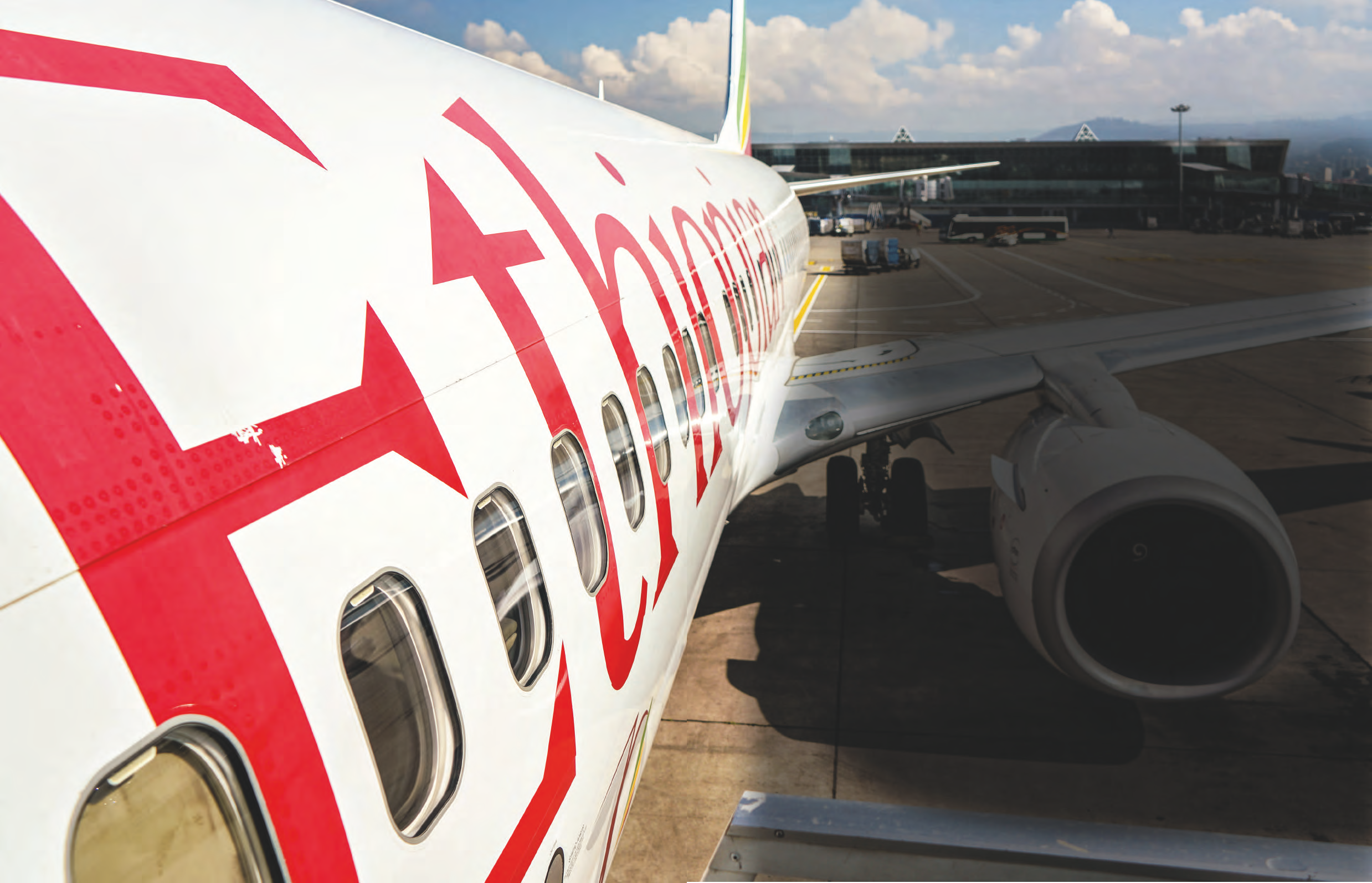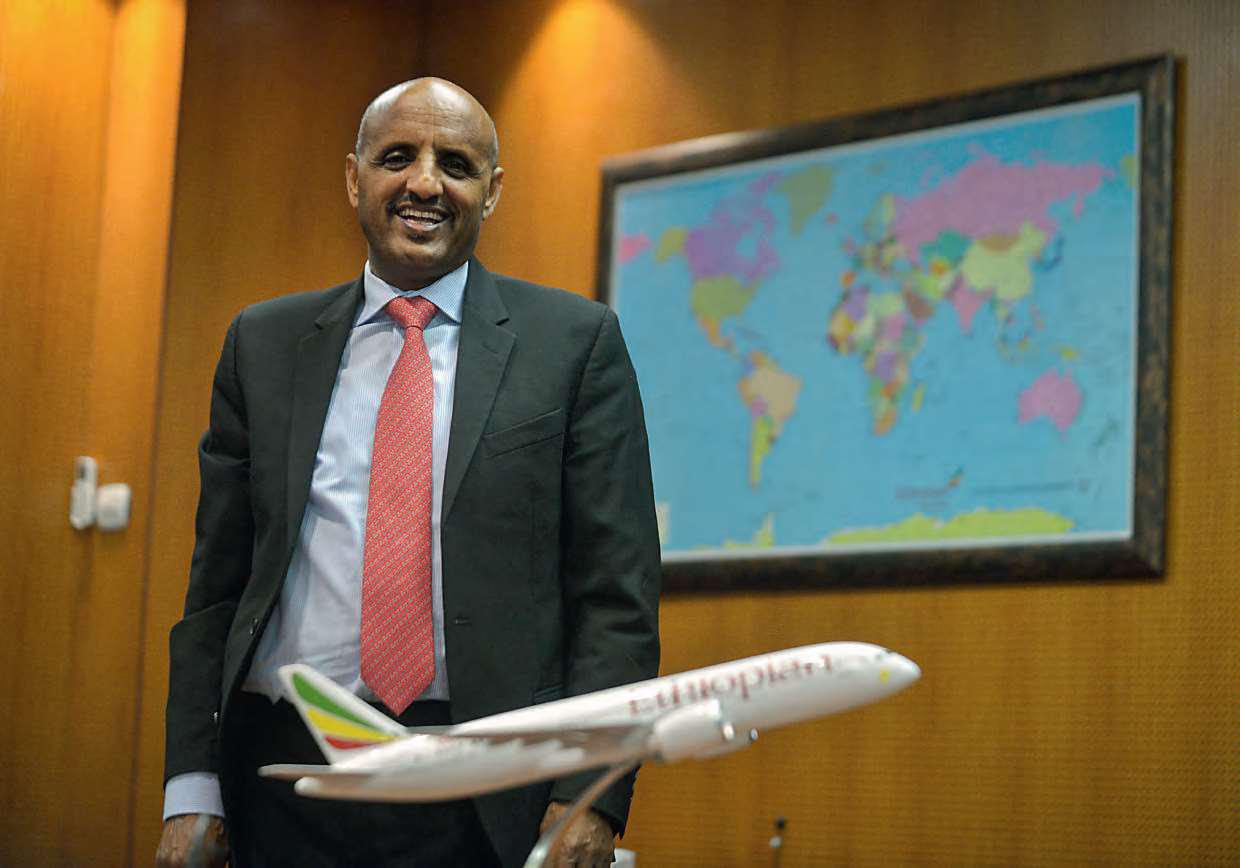The Ethiopian
Airlines enigma

The national airline now serves over 127 destinations in more than 80 countries across four continents, while being profitable. Despite successive crises, Ethiopian Airlines is a unique African success story.

Late November 2022. Somewhere in Paris, London, Frankfurt, Brussels, in the United States (New York, Washington...) or in Asia (Hong Kong, Seoul, Shanghai, Kuala Lumpur...), an Ethiopian Airlines plane is about to take off for Addis Ababa. Probably a new generation A350. These flights usually arrive early in the morning in the Ethiopian capital. Precisely at the Bole International Airport, which has just been expanded, with the extension of the terminal and a luxury hotel for transits. Planes are landing, others are preparing to leave for all over Africa - 61 cities in the last count. There are also East-West and North-South trips across the continent. On the tarmac, the activity is bustling, a virtual traffic jam with all those planes lined up, with green, yellow, and red tailplanes, the colors of Ethiopia. In the halls of the airport, the atmosphere is also surprising, groups of people from the four corners of the world, from the four corners of the continent. All languages are spoken – from Yoruba to Malinke, Arabic, Swahili, and English – and people wear boubous, suits, Mao collars and even white anti-Covid suits for Chinese travelers. In the business lounge, the privileged ones have a view on Addis Ababa, thanks to the long bay window. Everything is moving, everything is flying, and yet we are in Ethiopia, a huge and unstable country where civil war just ended. A country also at the heart of a real international hub, unique in Africa. An operational hub that is located in the "golden geographic zone", equidistant from the East and West of the planet, and competing with other major hubs Istanbul and Dubai. This is the mystery and the paradox of Ethiopian Airlines. Fully state-owned, the company operates almost independently, genuinely avoiding turbulences, from the bloody years of the dictatorship of the Provisional Military Government of Socialist Ethiopia (Derg, as it is called in Amharic) to the global crisis caused by Covid-19. Growing from 3.7 million passengers in 2011 to more than 12 million in 2019, it survived the shock of the pandemic in 2020 by heavily relying on cargo business, which became essential at the time, and by transforming its aircraft. The company has managed to contain the decline in its revenues ($3.908 billion in 2019, $3.749 billion in 2020), while preparing to rebound. It is protected from competition by a state shield: obtaining landing rights at Bole is particularly complicated for international carriers. Last September, Ethiopian Airlines was awarded Africa's best airline for the fifth consecutive year. This award was given by the leading rating agency of the airline industry, Skytrax. Proof of its excellence, it has moved from 37th place in the world's top 100 in 2021 to 26th place. Only five other continental companies appear in this ranking: Royal Air Maroc, South African Airways, Kenya Airways, Air Mauritius and Egyptair. To maintain this performance, Ethiopian relies on an African and pan-African development strategy, the efficiency of its hub, public protection, the modernity of the fleet, as well as an effort on the service on board, even if the purists could criticize a sometimes rough and random catering… Longevity and experience should not be forgotten: founded in December 1945, the company will celebrate its 80th anniversary in 2025.
BACK TO THE ROOTS
On April 8, 1946, a Douglas C-47 Skytrain took off from Lideta Airport in Addis Ababa on to join Cairo, via Asmara. This was Ethiopian Airlines inaugural flight. The first for an African airline. Discussions about its creation were initiated in 1942, under Emperor Haile Selassie. Through the establishment of a route network, the emperor wished to bring his country closer to the major communication channels and move away from the geographical isolation that was holding back Ethiopia's modernization. Negotiations started between the government and the American company Trans World Airlines (TWA). The creation of Ethiopian Air Lines (its name until 1965) was effective on December 21, 1945. The agreement stated that the management of the government-owned company would entirely be entrusted to TWA. At the beginning, the staff was exclusively composed of Americans, and the first international flights served Cairo, Aden, Djibouti, Khartoum, and Asmara. Over a period of nearly twenty years, the company developed numerous long-haul flights to West Africa (Nigeria, Ghana, and Liberia) and to Europe (Spain, Italy, Germany and Greece). The agreement also evolved during this period to give Ethiopians a greater role in the company: in 1953, its preamble stated that it should eventually entirely be operated by local staff. At the same time, the company was gaining considerable weight on the continent and entering the jet age. Wishing to acquire the latest Boeing aircraft, the company could no longer rely on the Lideta airport and its single runway. Therefore, it was decided to build a second one to accommodate the new aircraft: Bole Airport was inaugurated in 1961 and Ethiopian Airlines established its headquarters there. One year later, two Boeing 720s were delivered. In 1970, as the company grew, TWA moved from a management to an advisory role, and Ethiopian Semret Medhane was appointed managing director for the 25th anniversary of the company. The future flagship of the country was now flying on its own.

In September 1974, Haile Selassie was overthrown in a revolution that ended his imperial and decrepit regime. A period of eighteen years of bloody military dictatorship began. The junta, led by Mengistu Haile Mariam, installed a Marxist-Leninist single-party government advocating "Ethiopian socialism": the Derg was born. Its leaders quickly intervened in the company's internal affairs: they dismissed Semret Medhane and replaced him with a general. Their repeated interventions caused significant financial losses and, by the end of the 1970s, the airline was close to bankruptcy. Saving the airline was a necessity as it had become strategic, including for the Derg, thanks to its freight capacity, which allowed to open up the country. In 1980, its management convinced the Derg to appoint an experienced person as CEO: Captain Mohammed Ahmed. In order to he asked the government for less interventions in the internal affairs of the company. When the Derg requested the company to stop buying American planes and to deal with the Soviet Union (close to the regime), the management of Ethiopian Airlines collectively threatened to resign, forcing the Derg to give up. Such a change would have been disastrous for a company built on the American model, both on the technical and managerial sides. The company was able to keep expanding its fleet and was soon considered as an “unqualified success” by the renowned British weekly The Economist which highlighted “disastrous economy” in which the company was evolving at the time.
The compromises with the Derg illustrated the emergence of air transport as an economically crucial sector. Until the fall of the regime in 1991, conflict was permanent in the country. During this turbulent period, the airline managed to stay on course and remain one of the most profitable on the continent, taking strategic initiatives to improve efficiency and increasing intra-African routes. In agreement with the Kenyan authorities, the company also temporarily relocated its fleet to Nairobi, after it assessed the risks posed by the advance of the Ethiopian People's Revolutionary Democratic Front army.
A PIONEERING COMPANY
In the 21st century, with the return of "stability" in Addis, the company organized itself and enriched its catalog of international routes with South Africa, Asia (Beijing and Bangkok) and the United States. In 2005, it was overtaken by South African Airways, Egyptair and Kenya Airways in terms of number of passengers carried. So, it set up a plan to reach 3 million passengers in five years. This target was exceeded in 2010. Even more ambitious, the "2025-Vision" program was launched, with the aim of increasing the number of passengers and the size of the fleet. Ethiopian Airlines became the first African carrier in 2019, and continues to grow, taking advantage of the geographical position of the capital and increasing its market share on regional air transport. The aim is to capture regional or local traffic to intermediary hubs that are supposed to feed the Addis hub. This is "continuation" traffic. In 2013, the company took a 49% stake in Malawi Airlines. More recently, in 2021, by becoming a 45% shareholder in Zambia Airways, it provided strategic support that enabled this airline to resume operations after a twenty-seven-year absence. It also owns 40% of Asky Airlines, a pan-African company based in Togo that serves 24 countries in West and Central Africa. Asky Airlines also help developing the Lomé hub by making it an aviation maintenance and training specialized hub. Ethiopian can also count on other strategic partnerships, in Chad (Tchadia Airlines) and Equatorial Guinea (Ceiba Intercontinental), as well as an agreement with the government of the Democratic Republic of Congo for the launch of Air Congo’s activities, in which it has a 49% stake. The partnership with the Congolese government will include seven aircraft to be brought in by Ethiopian Airlines, Congolese to be sent to Addis Ababa for training and a maintenance center to be set up.

Ethiopian Airlines also wants to tackle the complex Nigerian market, one of Africa's greatest potentials. Its project to create a new national airline, Nigeria Air, was suspended following a legal action brought by several local competitors in November 2022. Since then, the situation has improved and, in February, the Minister of Aviation of Nigeria, Hadi Sirika, insisted: “Nigeria Air will soon start flying”. The regulatory approval to make Nigeria Air flying is at the final stage… While the case raised by local competitors still in court.
The company, which serves over 127 destinations in more than 80 countries, entered the world of international airline partnerships by joining the Star Alliance network in 2010: the world's leading network ahead of Oneworld (British Airways, Qatar Airways, etc.) and SkyTeam (Air France, Delta Air Lines, etc.). Star Alliance includes 26 companies (Lufthansa, Turkish Airlines, Singapore Airlines, etc.) and offers nearly 1,900 flights per day. Ethiopian Airlines also invests massively in training and in its fleet, with, on the one hand, a training center (opened in 1964) that prepares more than 1,500 students each year - from some 50 countries in Africa, Asia and Europe - and, on the other hand, a fleet of more than 140 aircraft, which has been modernized since the beginning of the 2010s, and which put the company ahead of the continental competition. After decades of exclusive partnership with Boeing, Ethiopian became the first airline on the continent to operate the Airbus A350-900 in 2016. Willing to stay on the cutting edge of technology and reduce fuel costs, it ordered four Airbus A350-1000s (480 passengers) last August. The company’s goal is to have more than 150 aircraft by 2025.
As the cornerstone of the company, Bole International Airport is an illustration of Ethiopian Airlines’ ambitions. With a capacity of nearly 22 million passengers per year since the completion of the construction of terminal 2 in 2020, it is one of the largest airports on the continent, behind Johannesburg, and in competition with Cairo for second place. The government's intention is to increase the already strained capacity. Shortly before the start of the health crisis and a few months before the war in Tigray, Ethiopian Airlines announced the construction of a new airport, covering an area of 35 km2 and with a capacity of 100 million passengers per year - which would make it the largest in Africa. The estimated cost reaches $5 billion. The site will be located in Bishoftu, 40km South from the capital. However, its construction faces many obstacles. The pandemic has delayed its implementation, and the civil war in Tigray has underlined the fragility of the country and dampened the enthusiasm of future international partners. After two calls for proposals, the company plans to review the project before launching a third one.

BE RESILIENT
Despite its success, Ethiopian is not completely immune to crises. The consequences of the Covid-19 pandemic, hitting tourism hard, have proved this. The company had to suspend 90% of its international flights at the peak of the crisis. As of June 30, 2020, it had a 5% drop in revenue compared to 2019. Tewolde GebreMariam, then CEO, declared that the company was "fighting for survival”. In an effort to overcome the crisis, the company decided to focus on its cargo business, converting 25 passenger planes into freighters to transport, primarily, medical equipment to more than 80 countries. Thanks to this strategy, the company largely mitigated the effects of the crisis and enhanced its image with international partners such as the World Health Organization and certain Asian and South American countries, for which it has provided connections allowing the delivery of vaccines, among other things. In early 2023, the company strengthened its cargo business with new routes to China: Xiamen (linked to Sao Paulo, Brazil, and Santiago, Chile) and Shenzhen (linked to Liège, Belgium). Through its partnership with MailAmericas, a US private postal operator, announced in January, the company went further diversifying its freight activities. It will now seek to develop competitive cross border e-commerce services within Africa and the Middle East, using Addis Ababa as a hub.
Most importantly, Ethiopian experienced one of the worst tragedies in its history on March 10, 2019. The Boeing 737 Max operating flight 302 Addis Ababa-Nairobi crashed six minutes after takeoff, killing 157 people, including the airline's youngest pilot, Yared Getachew. The plane's automated stall prevention system was to blame. Barely off Boeing's assembly lines, the 737 Max is a new-generation medium-haul aircraft that has already seen another crash on October 29, 2018. On that day, a Lion Air flight crashed into the sea in Indonesia, minutes after takeoff, killing 189 people. The scandal is resounding and affects the American manufacturer, which acknowledges its responsibility in the accident and makes an agreement with the families of the victims in late 2021. Three years after the crash, after extensive re-certifications, the Boeing 737 Max is back in Ethiopian Airlines’ fleet. But on August 15, 2022, on a flight from Khartoum to Addis Ababa, the two pilots fell asleep in the middle of the journey, not responding to the calls of the air traffic controllers. Fortunately, an autopilot alarm went off once the runway was passed, and the plane finally landed safely. Both pilots were suspended while waiting for the results of the internal investigation. The captain later decided to resign. But the bad memories came back. Furthermore, controversy over Ethiopian's role in the Tigray conflict erupted in late 2021. An investigation by the American channel CNN revealed documents indicating that the federal government, then at war with the Tigrayan rebels since November 2020, had used the company to transport arms to and from Eritrea. This was said to be a violation of international air law, as the transport of weapons for military use on civilian aircraft is considered smuggling. Ethiopian Airlines denied, but the evidence seemed credible. On November 23, without being really troubled about the issue, the company announced the resumption of flights to the Tigray region following the peace agreement signed between the government and rebels earlier in the month. On December 28, Ethiopian Airlines resumed daily flights to Tigray.
In March 2022, after more than eleven years at the helm of Ethiopian Airlines, the company's iconic figure, Tewolde GebreMariam, resigned, officially for health reasons. Mesfin Tasew, director of operations since 2010, succeeded him, without any turbulence. The company gave an image of continuity, but the challenges are significant: maintaining the competitiveness, independence and performance of a global company, a true African success story, in a complex international environment, with rising energy costs, the persistent threat of Covid... And above all, in the heart of a highly unstable Ethiopia, constantly torn by the demons of separatism and breakup. Again, this is the whole Ethiopian paradox.